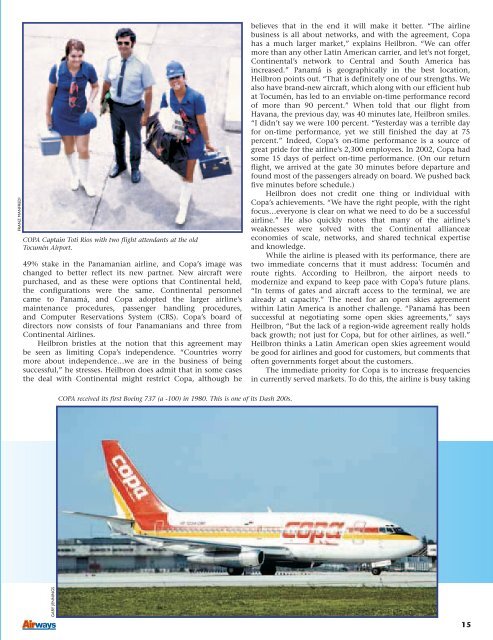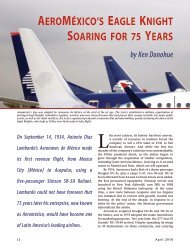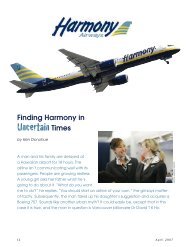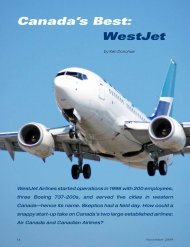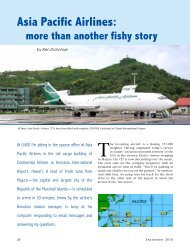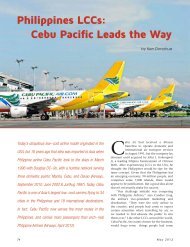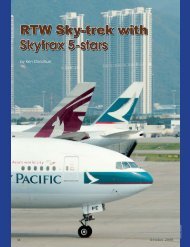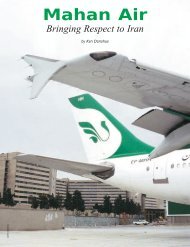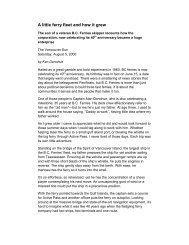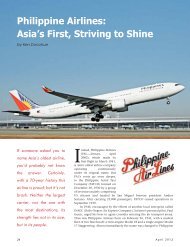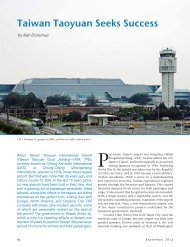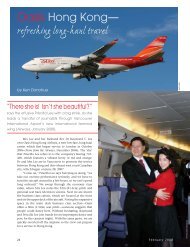Copa Airlines - Ken Donohue
Copa Airlines - Ken Donohue
Copa Airlines - Ken Donohue
You also want an ePaper? Increase the reach of your titles
YUMPU automatically turns print PDFs into web optimized ePapers that Google loves.
FRANZ MANFREDI<br />
COPA Captain Toti Rios with two flight attendants at the old<br />
Tocumén Airport.<br />
49% stake in the Panamanian airline, and <strong>Copa</strong>’s image was<br />
changed to better reflect its new partner. New aircraft were<br />
purchased, and as these were options that Continental held,<br />
the configurations were the same. Continental personnel<br />
came to Panamá, and <strong>Copa</strong> adopted the larger airline’s<br />
maintenance procedures, passenger handling procedures,<br />
and Computer Reservations System (CRS). <strong>Copa</strong>’s board of<br />
directors now consists of four Panamanians and three from<br />
Continental <strong>Airlines</strong>.<br />
Heilbron bristles at the notion that this agreement may<br />
be seen as limiting <strong>Copa</strong>’s independence. “Countries worry<br />
more about independence…we are in the business of being<br />
successful,” he stresses. Heilbron does admit that in some cases<br />
the deal with Continental might restrict <strong>Copa</strong>, although he<br />
believes that in the end it will make it better. “The airline<br />
business is all about networks, and with the agreement, <strong>Copa</strong><br />
has a much larger market,” explains Heilbron. “We can offer<br />
more than any other Latin American carrier, and let’s not forget,<br />
Continental’s network to Central and South America has<br />
increased.” Panamá is geographically in the best location,<br />
Heilbron points out. “That is definitely one of our strengths. We<br />
also have brand-new aircraft, which along with our efficient hub<br />
at Tocumén, has led to an enviable on-time performance record<br />
of more than 90 percent.” When told that our flight from<br />
Havana, the previous day, was 40 minutes late, Heilbron smiles.<br />
“I didn’t say we were 100 percent. “Yesterday was a terrible day<br />
for on-time performance, yet we still finished the day at 75<br />
percent.” Indeed, <strong>Copa</strong>’s on-time performance is a source of<br />
great pride for the airline’s 2,300 employees. In 2002, <strong>Copa</strong> had<br />
some 15 days of perfect on-time performance. (On our return<br />
flight, we arrived at the gate 30 minutes before departure and<br />
found most of the passengers already on board. We pushed back<br />
five minutes before schedule.)<br />
Heilbron does not credit one thing or individual with<br />
<strong>Copa</strong>’s achievements. “We have the right people, with the right<br />
focus…everyone is clear on what we need to do be a successful<br />
airline.” He also quickly notes that many of the airline’s<br />
weaknesses were solved with the Continental allianceæ<br />
economies of scale, networks, and shared technical expertise<br />
and knowledge.<br />
While the airline is pleased with its performance, there are<br />
two immediate concerns that it must address: Tocumén and<br />
route rights. According to Heilbron, the airport needs to<br />
modernize and expand to keep pace with <strong>Copa</strong>’s future plans.<br />
“In terms of gates and aircraft access to the terminal, we are<br />
already at capacity.” The need for an open skies agreement<br />
within Latin America is another challenge. “Panamá has been<br />
successful at negotiating some open skies agreements,” says<br />
Heilbron, “But the lack of a region-wide agreement really holds<br />
back growth; not just for <strong>Copa</strong>, but for other airlines, as well.”<br />
Heilbron thinks a Latin American open skies agreement would<br />
be good for airlines and good for customers, but comments that<br />
often governments forget about the customers.<br />
The immediate priority for <strong>Copa</strong> is to increase frequencies<br />
in currently served markets. To do this, the airline is busy taking<br />
COPA received its first Boeing 737 (a -100) in 1980. This is one of its Dash 200s.<br />
GARY JENNINGS<br />
15


